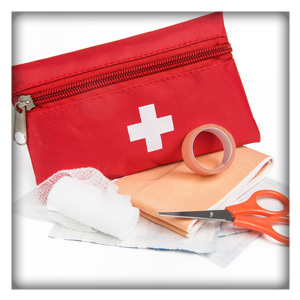
Everyone should have a smartly prepared and well thought out first aid kit. This is something that we hope that you will never need, but in todays world it is better to be ready to treat a cut or wound with the correct materials than to be without.
Where do you keep a first aid kit?
In your car, motorcycle, ATV, or boat: If you are in a traffic accident or are witness to one, your vehicle is a no brainer place to have a well stocked First Aid kit. There also plenty off times where you will be attending events, or have your vehicle near.
In your home: Besides you medicine cabinet it is not a bad idea of have a portable kit that can be transported in the event of an accident where a victim may need to be stationary.
At your place of work: The type of work you do or your surroundings will determine the contents and depth of your first aid kit.
On your person: If you enjoy hiking, going to the beach, or participating in outdoor sports, you would be wise to keep a small, but thoughtfully stocked first aid kit in your backpack, purse, or equipment bag.
There are several places you can purchase an already stocked first aid kit. You can purchase them online, from your local drug store, and many retail outlets, however, it is best to customize your first aid kit based on your interests, surroundings, and the people who you surround yourself with.
No matter what or where your first aid kit lives, it would be wise to include and do the following:
- Include medications to combat allergic reactions (if applicable)
- Emergency phone numbers
- Specific health-care provider information
- Set up scheduled dates to check the kit
- Check expiration dates and replace any used or out-of-date contents
The Red Cross recommends that all first aid kits for a family of four include the following:
- 2 absorbent compress dressings (5 x 9 inches)
- 25 adhesive bandages (assorted sizes)
- 1 adhesive cloth tape (10 yards x 1 inch)
- 5 antibiotic ointment packets (approximately 1 gram)
- 5 antiseptic wipe packets
- 2 packets of aspirin (81 mg each)
- 1 blanket (space blanket) [Available on the Red Cross Store]
- 1 breathing barrier (with one-way valve)
- 1 instant cold compress
- 2 pair of nonlatex gloves (size: large)
- 2 hydrocortisone ointment packets (approximately 1 gram each)
- Scissors
- 1 roller bandage (3 inches wide)
- 1 roller bandage (4 inches wide)
- 5 sterile gauze pads (3 x 3 inches) [Available on the Red Cross Store]
- 5 sterile gauze pads (4 x 4 inches)
- Oral thermometer (non-mercury/nonglass)
- 2 triangular bandages
- Tweezers
For the following reasons Hy-Tape makes an excellent addition to any and all First Aid kits.
- It is waterproof – Once applied to a clean, dry surface the tape will adhere in the presence of moisture.
- It is flexible – The tape will stretch, it can be torn easily, and conforms to difficult areas.
- It is gentle – While holding firmly, Hy-Tape will release gently and thanks to the zinc oxide based adhesive, the tape, more times than not, will leave even the most sensitive skin intact and healthy.
- It is thin and smooth – While hiking, running, or biking blisters may occur. Hy-Tape will protect the areas where friction is causing the skin distress and resist curling and coming off.
- It is easy to use – Hy-Tape is easy to tear and can be used on all types of surfaces.
Our Products
Hy-Tape Pre-Cut Strips make a great and easy self contained addition to any First Aid kit.
Multicut Hospital Tube are available in 7 different widths and also in an assortment tube.

